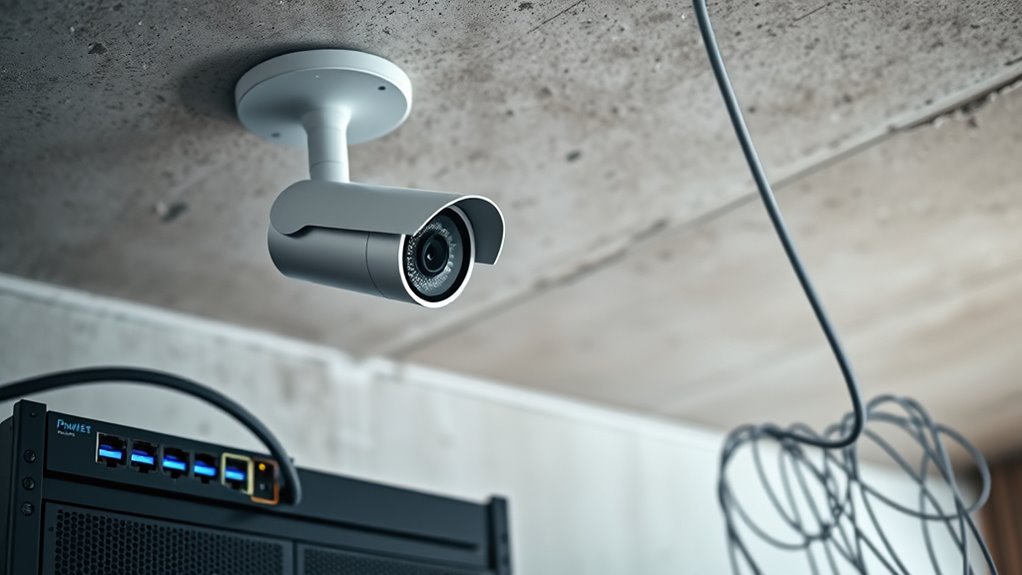Using Power over Ethernet (PoE) for security devices makes installation easier by combining power and data in one cable, reducing clutter and costs. It offers flexibility and simplifies management, but you’ll depend on a stable network, and power or connectivity issues can cause downtime. Compatibility with equipment and future-proofing are important considerations. To understand how to maximize PoE’s benefits while managing its limitations, explore the full details below.
Key Takeaways
- PoE simplifies installation by combining power and data in a single cable, reducing clutter and installation time.
- It offers cost savings through reduced wiring, power supplies, and easier device scalability.
- Reliance on network connectivity means outages can disable security devices, creating potential security gaps.
- Compatibility depends on adherence to standards like IEEE 802.3af/at, requiring compatible equipment for reliable operation.
- Emerging standards support higher power levels, future-proofing security systems but require planning to manage network dependency.
Simplified Installation Process
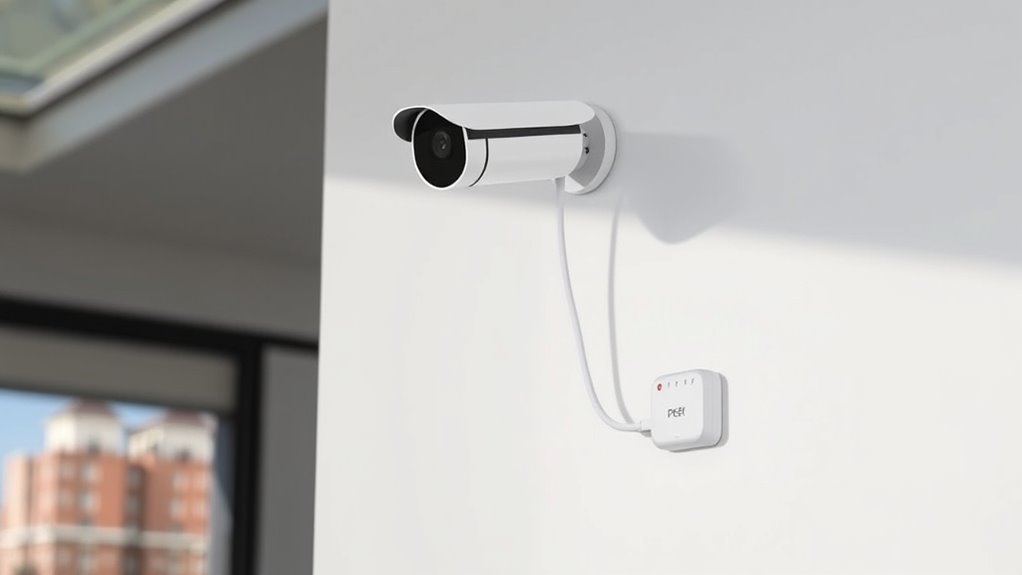
Because Power over Ethernet (PoE) combines power and data delivery into a single cable, installing security devices becomes much simpler. With PoE, you eliminate the need for separate power outlets, enabling easier placement of cameras and sensors. This streamlined setup enhances wireless integration, allowing your devices to connect seamlessly with existing networks. You can also easily implement remote monitoring, since fewer cables mean less hassle and more flexibility in positioning your security equipment. PoE simplifies the installation process, reducing labor time and minimizing potential errors. Additionally, the color accuracy of PoE-enabled devices ensures clearer video quality, which is crucial for security purposes. Whether you’re upgrading an existing system or installing a new one, PoE’s straightforward approach makes it easier to deploy reliable, connected security devices with minimal disruption. This efficient setup ultimately saves you time and resources.
Reduced Clutter and Cable Management
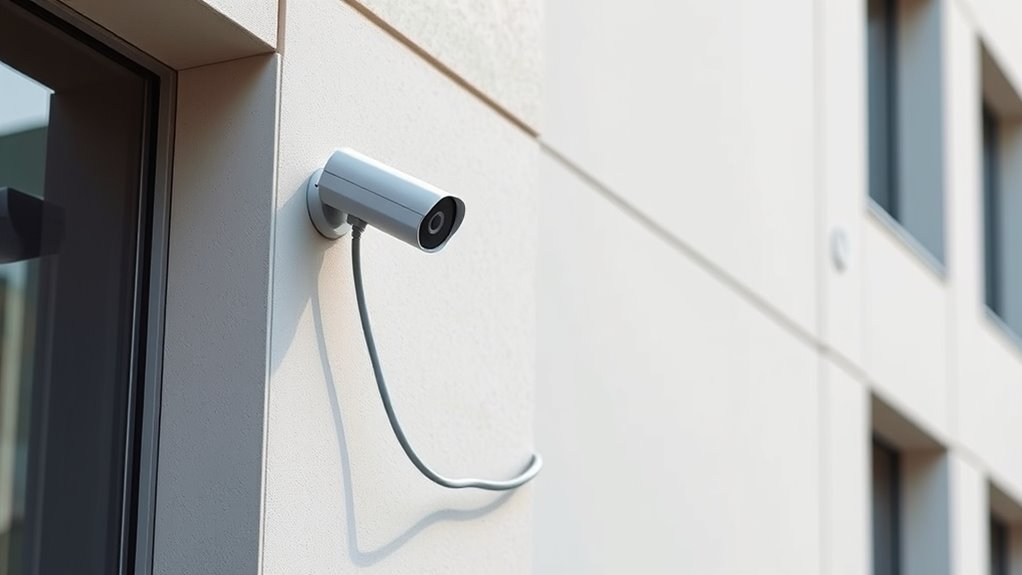
Power over Ethernet substantially reduces clutter by consolidating power and data into a single cable. This streamlines your setup, making wireless security devices look cleaner and more professional. With fewer cables, you’ll enjoy a neater environment, easier maintenance, and improved aesthetic design. Here are some benefits:
- Simplifies installation, reducing the need for multiple power outlets and cables.
- Enhances wireless security device placement, offering more flexibility without tangled cords.
- Creates a sleek, organized look that minimizes visual distraction and clutter.
- Using professional-grade equipment ensures optimal performance and reliability for your security system.
This streamlined approach not only improves the appearance of your security setup but also makes cable management straightforward, saving you time and effort in the long run. PoE helps you achieve a tidy, efficient, and modern security system.
Cost-Effective Setup

Implementing Power over Ethernet can substantially reduce your overall security setup costs by eliminating the need for multiple power supplies and extensive wiring. This integration simplifies installation, leading to significant cost savings on hardware and labor. With PoE, you only need a single cable per device, reducing the expenses associated with separate power outlets and wiring infrastructure. This streamlined approach makes budget planning easier, as you can accurately forecast expenses and avoid unexpected costs. Additionally, using existing Ethernet cabling can cut down on material costs and installation time. Overall, PoE provides a more affordable way to deploy security devices, helping you optimize your security budget without compromising on performance or coverage. Pimple Patch technologies demonstrate how targeted solutions can improve efficiency and effectiveness in various applications.
Enhanced Flexibility and Scalability
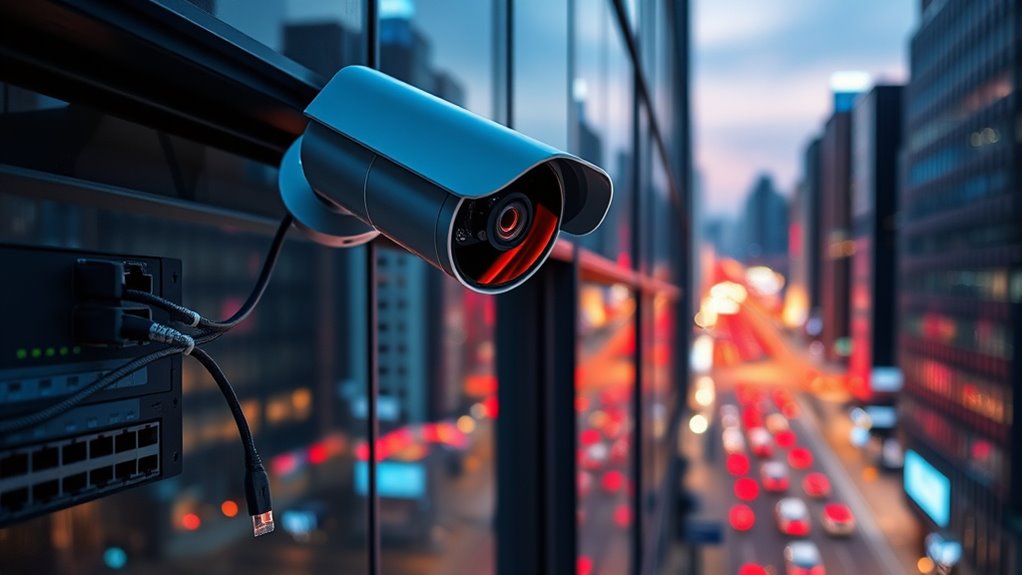
One of the key advantages of Power over Ethernet is its ability to enhance flexibility and scalability in your security setup. With PoE, you can easily add or relocate devices without major rewiring, making future expansion seamless. It also simplifies remote management, allowing you to control and configure devices centrally, reducing onsite visits. To maximize these benefits, consider the following:
- Easily expand your network by connecting new security cameras or sensors without additional power sources.
- Address scalability challenges proactively, knowing that PoE can handle growing device demands.
- Streamline remote management to monitor, troubleshoot, and adjust devices remotely, saving time and resources.
- Proper planning ensures that your PoE network remains efficient and capable of supporting increased device loads as your security needs evolve.
This adaptability guarantees your security system can grow with your needs, avoiding costly upgrades or complex wiring.
Reliable Power Delivery
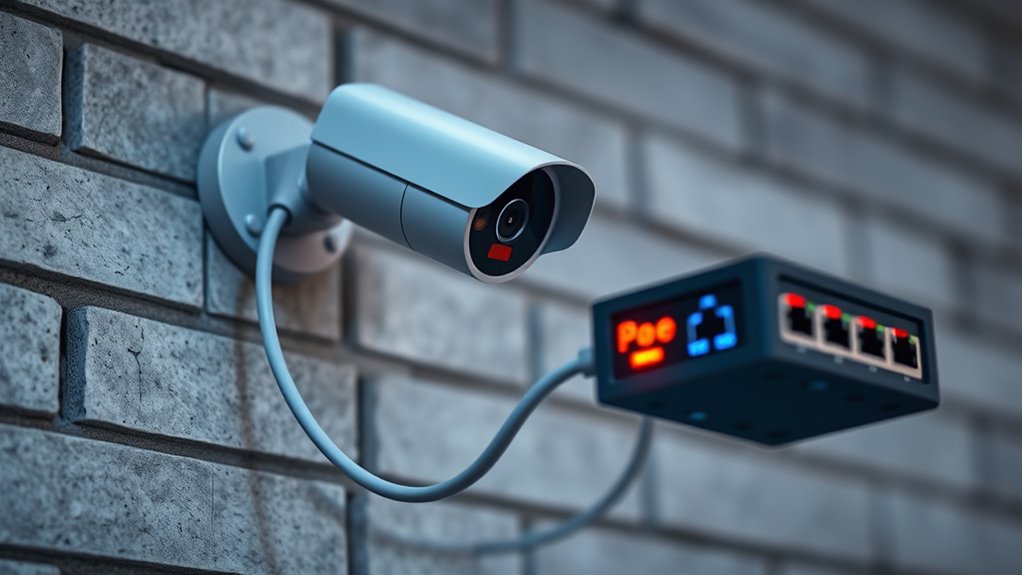
Reliable power delivery guarantees your security devices stay operational without interruptions. You can count on a consistent power supply that keeps your systems running smoothly. This reduces the risk of downtime caused by power fluctuations or outages. Additionally, power over ethernet (PoE) simplifies installation by consolidating data and power into a single cable, reducing complexity and potential points of failure.
Consistent Power Supply
To guarantee security devices operate effectively, a consistent power supply is essential. PoE helps provide reliable power, but interruptions can still occur without additional safeguards. To ensure uninterrupted operation, consider: 1. Implementing redundant power sources, so if one fails, another takes over seamlessly. 2. Using backup batteries to keep devices running during power outages. 3. Regularly checking connections and power equipment to prevent unexpected failures. Additionally, monitoring power consumption can help detect issues before they cause disruptions.
Reduced Power Interruptions
Have you ever experienced a security device suddenly shutting down? Power interruptions like power outages can cause this, risking your security coverage. PoE provides more reliable power delivery, reducing such disruptions. Because PoE systems are often connected to centralized power sources with surge protection, they’re better equipped to handle power fluctuations and surges. This setup minimizes downtime caused by electrical issues, ensuring your security devices stay operational. Unlike traditional power methods, PoE allows for continuous power even during minor outages, especially if paired with uninterruptible power supplies (UPS). As a result, you gain peace of mind knowing your security infrastructure remains active and protected, maintaining constant surveillance without interruption. Additionally, understanding security device power requirements can help optimize your system’s reliability.
Limited Distance for Power and Data Transmission

Power over Ethernet (PoE) faces a significant limitation in the distance over which power and data can be transmitted effectively. This restriction stems from signal degradation, which weakens data signals over longer cables, and installation constraints, such as cable length restrictions. As you extend the cable beyond recommended limits, you risk losing power and data integrity. To manage this, consider the following:
- Keep cable runs under 100 meters (328 feet) to maintain reliable transmission.
- Use high-quality, shielded cables to reduce signal degradation.
- Employ PoE extenders or switches to boost signals for longer distances.
- Understanding power transmission limits is crucial for designing effective network setups.
These measures guarantee your devices stay powered and connected, but they also highlight the importance of planning your installation carefully.
Dependence on Network Infrastructure
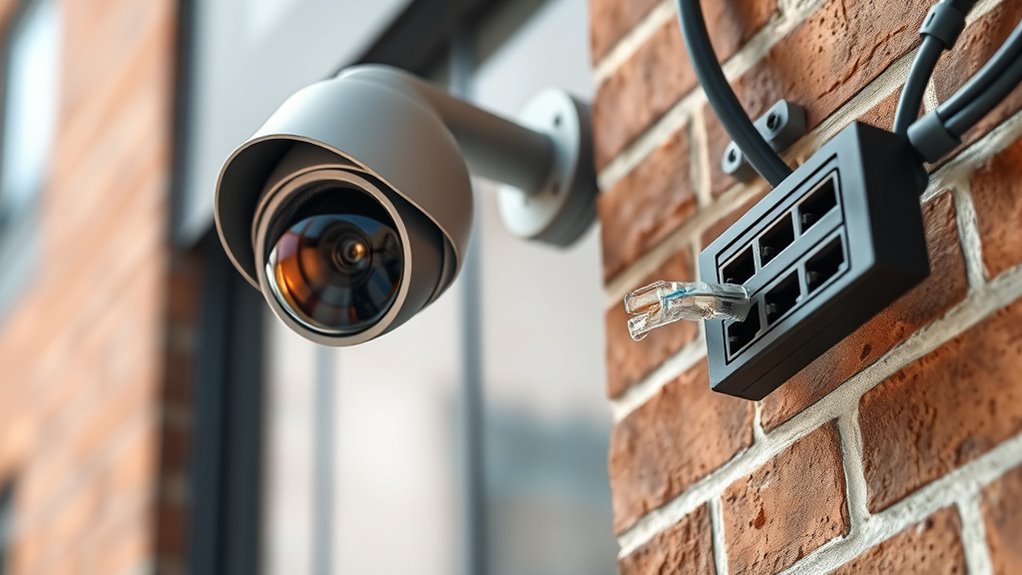
Extending PoE connections relies heavily on a robust network infrastructure, making your entire system vulnerable if that foundation isn’t solid. A failure in your network can cause a single point failure, shutting down multiple devices simultaneously. This network dependency means your security setup depends on consistent connectivity. If your network experiences issues, devices may lose power or data transmission stops, reducing security effectiveness. To understand this better, consider the following:
| Network Dependency | Impact on Security Devices |
|---|---|
| Single Point Failure | A single network issue affects all connected devices |
| Network Reliability | Essential for continuous power and data flow |
| Redundancy Need | Multiple pathways mitigate failures |
| Maintenance | Network upkeep is critical for system integrity |
Being aware of this dependence helps you plan for reliable network infrastructure, including network monitoring to proactively address potential issues.
Potential Power and Network Interruptions
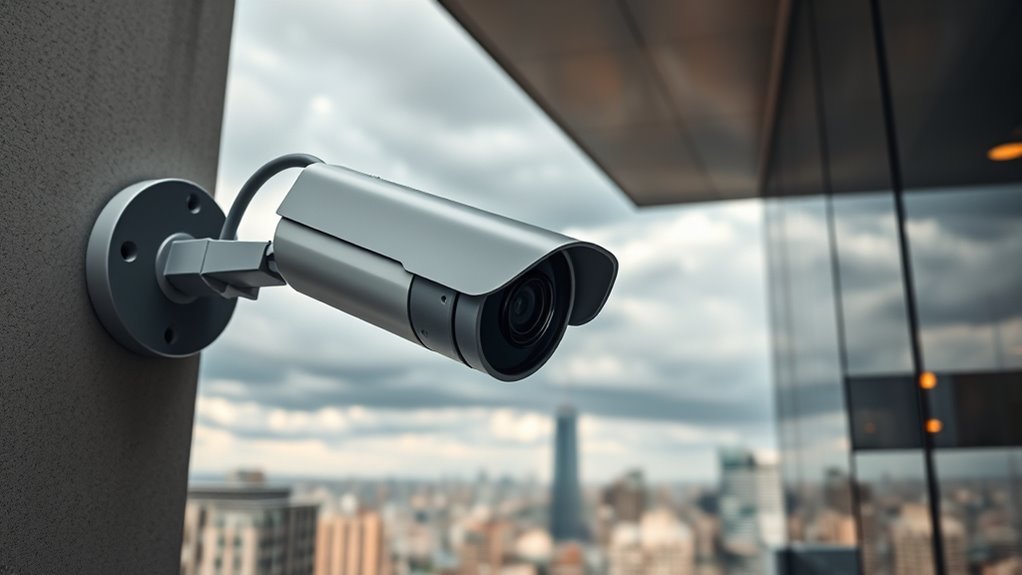
Despite the advantages of Power over Ethernet (PoE), your security devices remain vulnerable to potential power and network interruptions. Power outages or network failures can disable cameras or alarms unexpectedly. Here are three key issues to contemplate:
- Power outages can cut off power supply, halting device operation until power is restored.
- Network failures may disrupt data transmission, affecting real-time monitoring and recording.
- Both issues can compromise security, leaving blind spots during critical moments.
- To mitigate these risks, understanding and addressing passive voice detection can improve communication clarity and system reliability.
These interruptions can cause security lapses or data loss, emphasizing the importance of backup plans. Relying solely on PoE makes your system susceptible to these vulnerabilities, especially in environments prone to outages. Preparing for such disruptions helps maintain continuous security coverage.
Compatibility and Equipment Requirements
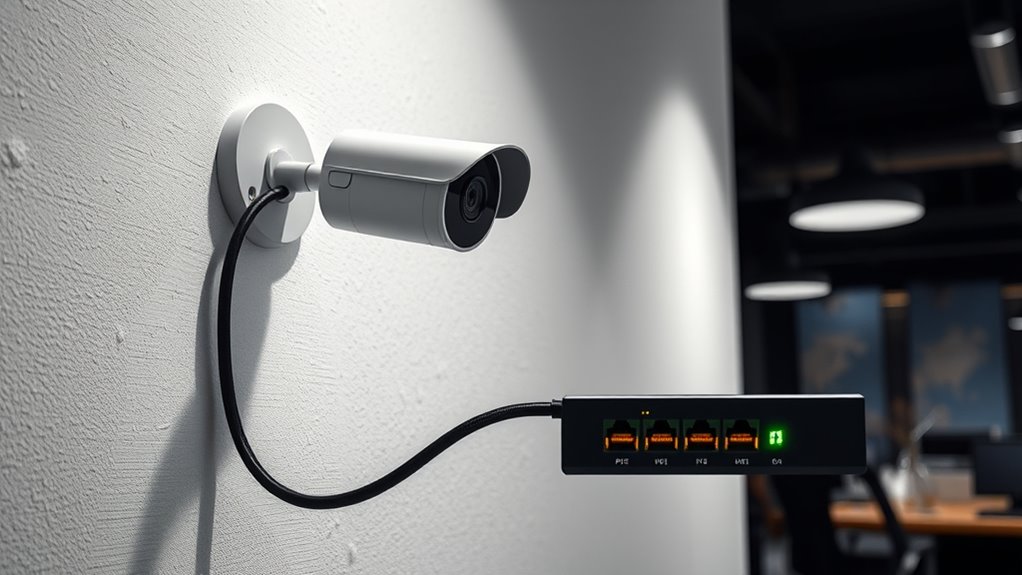
To make certain your security devices work seamlessly with Power over Ethernet, you need to check their compatibility with device standards like IEEE 802.3af and 802.3at. You’ll also want to verify that your power injectors and switches support these standards and provide sufficient power. Additionally, confirm that your network infrastructure can handle the power and data requirements without issues.
Compatible Device Standards
When selecting Power over Ethernet (PoE) for security devices, ensuring compatibility between the power source and the device is vital. You need to focus on device interoperability and standard compliance to avoid issues. First, confirm that your device supports PoE standards like IEEE 802.3af or 802.3at, which define power levels and communication protocols. Second, check if your network switch or injector complies with these standards to guarantee proper power delivery. Third, verify that your security device explicitly states compatibility with these standards to ensure seamless operation. Staying within compatible device standards prevents power mismatches, reduces hardware conflicts, and ensures reliable, efficient performance for your security setup.
Power Injector Necessities
Selecting the right power injector is key to ensuring your security devices receive consistent and reliable power. You need a power injector compatible with your device’s requirements, whether it’s PoE or PoE+ standards. Check that the power source you choose matches the voltage and wattage specifications of your injector. Some injectors are designed for standalone use, while others integrate seamlessly with network switches, so verify compatibility beforehand. Consider whether your power source can supply enough current to handle multiple devices if needed. Using an incompatible power injector or a mismatched power source can lead to power failures or device malfunctions. Ensuring compatibility and proper equipment requirements will keep your security devices powered efficiently and reduce troubleshooting down the line.
Network Infrastructure Compatibility
Ensuring your network infrastructure supports Power over Ethernet (PoE) devices requires verifying compatibility between your equipment. First, check that your switches and injectors support the correct network protocol, such as IEEE 802.3af or 802.3at, to deliver power properly. Second, confirm device interoperability by ensuring your security cameras or access points are compatible with your existing hardware. Third, verify your cabling meets the necessary standards—preferably Cat5e or higher—to handle the combined power and data transmission effectively. Addressing these factors helps prevent issues like power delivery failures or communication disruptions. Investing time in compatibility checks ensures your network infrastructure can reliably support PoE devices, streamlining installation and ongoing operation.
Future-Proofing and Technological Advancements
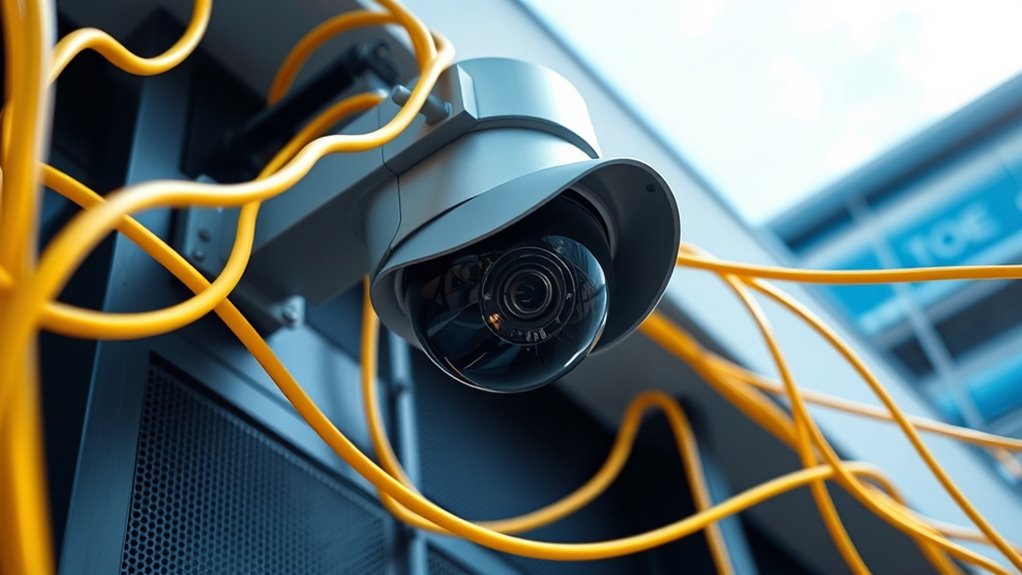
Advancements in Power over Ethernet (PoE) technology are making it easier to future-proof security devices against rapid changes in the industry. Emerging technologies like 802.3bt and 802.3at standards ensure your devices can handle higher power levels and faster data transfer, accommodating future upgrades. Industry standards are evolving to support increased bandwidth, smart features, and integration with other systems, so your security setup remains compatible with upcoming innovations. By choosing PoE solutions aligned with these standards, you diminish the need for costly replacements or upgrades down the line. Staying informed about emerging technologies allows you to select adaptable equipment that can grow with your security needs, ensuring your investments stay relevant and effective for years to come.
Frequently Asked Questions
How Does Poe Impact Overall Network Security?
Power over Ethernet can influence your network security by increasing potential vulnerabilities through device authentication challenges. If not properly secured, PoE devices might become entry points for cyberattacks, raising your network vulnerability. However, with strong authentication protocols and regular monitoring, you can mitigate these risks. Properly managed, PoE supports security devices without compromising your network’s integrity, ensuring both convenience and protection.
Can Poe Support High-Power Security Devices Effectively?
Imagine you’re in the 21st century, and yes, PoE can support high-power security devices, but with limitations. Power limitations mean you might need additional equipment or upgrades, and installation challenges could arise, especially with complex setups. While PoE simplifies wiring and offers convenience, guarantee your devices don’t exceed power thresholds to maintain reliable operation. Proper planning helps you leverage PoE effectively for high-power security needs.
What Are the Best Practices for Poe Device Placement?
When considering device placement, you should focus on ideal positioning for security effectiveness and ease of access. make certain your PoE devices are placed where cable management is straightforward, avoiding tight bends or excessive length that could affect performance. Keep devices close enough to power sources to prevent voltage drop, and plan the layout to minimize interference. Proper device placement and cable management enhance reliability and simplify maintenance.
How Does Poe Compare to Traditional Power Sources for Security Systems?
Comparing PoE to traditional power sources is like choosing between a reliable river and a complex pipeline. PoE offers better power reliability because it guarantees a steady flow directly through your Ethernet cables. Plus, it provides greater installation flexibility, letting you place security devices anywhere the network reaches without worrying about nearby outlets. Traditional power requires more wiring, making setups more cumbersome, but it still offers strong backup options in some cases.
Are There Specific Network Configurations Required for Poe Security Devices?
You need a specific network topology to support PoE security devices effectively. Make certain your network includes switches compatible with PoE power supply, providing adequate power levels for your devices. Proper configuration involves connecting security cameras or access points to these switches, which supply both data and power through a single cable. This setup simplifies installation and reduces clutter, but it requires careful planning of your network topology to maintain reliable power and data transmission.
Conclusion
When choosing PoE for your security devices, weigh the benefits against the drawbacks. While it streamlines setup and saves costs, it also ties your devices to your network’s stability. Don’t put all your eggs in one basket—plan for potential power or connection hiccups. Ultimately, embracing PoE is a leap of faith, but with careful planning, you can turn a rocky road into a smooth ride toward a secure, scalable system.
